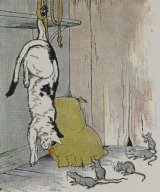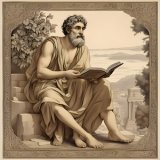The Cat and the Old Rat
"The Cat and the Old Rat" by Aesop is a fable about an old, wise rat and a cunning cat. It centers around the themes of wisdom, cunningness and the value of experience. The cat attempts to trick the rat into becoming his next meal by playing dead. However, the rat uses his experience and wisdom to outsmart the cat, teaching young readers about the importance of not falling for the obvious trickery and valuing wisdom that comes with age.
There was once a Cat who was so watchful, that a Mouse hardly dared show the tip of his whiskers for fear of being eaten alive. That Cat seemed to be everywhere at once with his claws all ready for a pounce. At last the Mice kept so closely to their dens, that the Cat saw he would have to use his wits well to catch one. So one day he climbed up on a shelf and hung from it, head downward, as if he were dead, holding himself up by clinging to some ropes with one paw. When the Mice peeped out and saw him in that position, they thought he had been hung up there in punishment for some misdeed. Very timidly at first they stuck out their heads and sniffed about carefully. But as nothing stirred, all trooped joyfully out to celebrate the death of the Cat. Just then the Cat let go his hold, and before the Mice recovered from their surprise, he had made an end of three or four. Now the Mice kept more strictly at home than ever. But the Cat, who was still hungry for Mice, knew more tricks than one. Rolling himself in flour until he was covered completely, he lay down in the flour bin, with one eye open for the Mice. Sure enough, the Mice soon began to come out. To the Cat it was almost as if he already had a plump young Mouse under his claws, when an old Rat, who had had much experience with Cats and traps, and had even lost a part of his tail to pay for it, sat up at a safe distance from a hole in the wall where he lived. "Take care!" he cried. "That may be a heap of meal, but it looks to me very much like the Cat. Whatever it is, it is wisest to keep at a safe distance." The wise do not let themselves be tricked a second time.
Translation
Translate and read this book in other languages:
Select another language:
- - Select -
- 简体中文 (Chinese - Simplified)
- 繁體中文 (Chinese - Traditional)
- Español (Spanish)
- Esperanto (Esperanto)
- 日本語 (Japanese)
- Português (Portuguese)
- Deutsch (German)
- العربية (Arabic)
- Français (French)
- Русский (Russian)
- ಕನ್ನಡ (Kannada)
- 한국어 (Korean)
- עברית (Hebrew)
- Gaeilge (Irish)
- Українська (Ukrainian)
- اردو (Urdu)
- Magyar (Hungarian)
- मानक हिन्दी (Hindi)
- Indonesia (Indonesian)
- Italiano (Italian)
- தமிழ் (Tamil)
- Türkçe (Turkish)
- తెలుగు (Telugu)
- ภาษาไทย (Thai)
- Tiếng Việt (Vietnamese)
- Čeština (Czech)
- Polski (Polish)
- Bahasa Indonesia (Indonesian)
- Românește (Romanian)
- Nederlands (Dutch)
- Ελληνικά (Greek)
- Latinum (Latin)
- Svenska (Swedish)
- Dansk (Danish)
- Suomi (Finnish)
- فارسی (Persian)
- ייִדיש (Yiddish)
- հայերեն (Armenian)
- Norsk (Norwegian)
- English (English)
Citation
Use the citation below to add this book to your bibliography:
Style:MLAChicagoAPA
"The Cat and the Old Rat Books." Literature.com. STANDS4 LLC, 2025. Web. 22 Feb. 2025. <https://www.literature.com/book/the_cat_and_the_old_rat_2390>.








Discuss this The Cat and the Old Rat book with the community:
Report Comment
We're doing our best to make sure our content is useful, accurate and safe.
If by any chance you spot an inappropriate comment while navigating through our website please use this form to let us know, and we'll take care of it shortly.
Attachment
You need to be logged in to favorite.
Log In